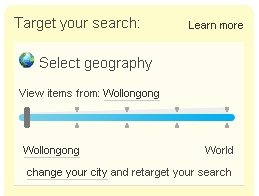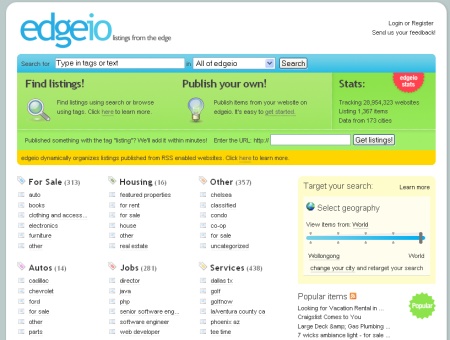Edgeio
Edgeio Launches. 
After much anticipation and a period of being available to a private audience the team at Edgeio took the covers off of their creation tonight and launched to the general public. Edgeio takes listings (classifieds) from RSS-enabled sources and organizes them in a central location for users to be able to browse and search. The Edgeio ethos is that content belongs on the edges, and that is where the name originates from (Edge input/output). Content on the edges means the content on the millions of blogs and other sites out there which Edgeio does a good job of aggregating and organizing.
From a seller’s perspective, to post an item you write about it on your blog and tag it ‘listing’ (along with any other keywords which are suitable to categorize the item for sale). Edgeio taps into the blog cloud via weblogs.com and other ping services (as well as its own ping server which is at http://www.edgeio.com/RPC2) to find new posts that have been tagged for listing. Once it finds your post, which usually happens very quickly, it will send a trackback to your post to make you aware that Edgeio has found it. Once you have posted, the first time you post an item you will need to go to Edgeio to claim your blog (a process that works similar to Technorati’s) from which point you can add additional metadata to your listing within Edgeio. The additional data you enter includes things like additional tags to categorize the item, your geographic location (which again you only enter once and is used when you search for items to buy as well) and the price of the item. It only takes moments from the time you post your listing to the time that it appears in Edgeio and is available for buyers to find.

From a buyers perspective, you can go to Edgeio and then find items that are for sale a number of ways. The first and most obvious way is to enter terms into the search box. This will display results which are item summaries sorted in chronological order. The other way to find items is by browsing through the tag clusters that are located on the front page and working your way down to items that interest you. The last way in which you can find items is interesting, as Edgeio has lists of most popular items, the latest items and the most active weblogs posting items. The popular items list and the latest items list have feeds available for users to subscribe to or use in other applications. One cool thing you notice is the geography slider widget that is persistently in the sidebar while you are looking through items. If you are looking at search results and would like to filter them down to just the state you are in, or the zip code you are in, then you just slide the slider. I have been told that this slider will be even more fine-grained in the near future by giving ’slide points’ which are certain distance radiuses around the current points (eg. Within 10 miles of your current post code). The way the slider works and refreshes the results or the page automatically has been very well implemented and makes a lot of sense. The interface has been very well done, it is clean and easy to understand (I tested this by handing over the URL to a non-tech user and they were able to find listings the may be interested in).
Throughout the search results, listings from blogs that have been claimed gain precedence over unclaimed listings. In the future sellers will have the ability to highlight their listing for a small fee. Reputation is currently handled via third party sites, the seller has an option to associate their listing with their Flickr, eBay or LinkedIn account so that their credibility can be traced back. It appears at the moment that a lot of the transactions on Edgeio will be face-to-face transactions, where verifying credibility is different as opposed to when you are sending payment to somebody you don’t know in a foreign country or another state.
The whole point of Edgeio is to connect the buyer and seller through its platform that aggregates listings, so there are no payment options at the moment nor can you see any account history from buyers or sellers on what they have purchased or sold before. It is currently being left up to the buyer and seller to close the transaction. Edgeio also offers a lot of social controls as a means to keep the listing relevant and current. Users are able to mark a listing as being ‘bad’ by telling Edgeio that the item is spam, that it is no longer current, that is hasn’t been categorized correctly or that the publishers information is not accurate. These forms of social controls and filtering work well on sites such as Craigslist and their effect on Edgeio and how well they work to prevent spam will only be known over time.
On important aspect to Edgeio is the availability of feeds for every part of the system. With standard RSS feeds (Dave Winer is an advisor to the company) developers of other applications or webmasters are able to include items for sale on Edgio into their own sites or applications, or take the listings further in some form of a mashup (I am guessing we will see the first mashups ?Äì potentially with Google Maps, shortly). I like the idea of being able to subscribe to a feed that will display new items that may not be available now but I wish to purchase ?Äì so I will see them as soon as they are posted.
I subscribe to the theory that the publishing and control of content belongs to the user and that we are heading in that direction. There are a few reasons for this, the first and most important is that the user owns his or her data, even if it is something as simple as a classified listing, so the user should be able to have effective control over the environment where this data is contained. With centralized services such as eBay and Craigslist the buyer and seller are left to the mercy of the platform provider. Blogging has enabled users to create content and publish it on the web easily, so using that platform for listings is only one of a number of potential services that can be built on top of what we have today. The short-term barriers I foresee are the size of this market today and how effective Edgeio will be in promoting itself as the standard place for listings. In terms of scalability, only a much larger inventory will be able to test the theory of having tags and tag clusters as a directory as opposed to a rigid directory structure (which is very hard to maintain and expand). Edgeio is putting categorization and the categories themselves into the hands of users with self-monitoring in place that will attempt to assure that things don?Äôt get out of hand. While having 1,300 or so listings at the time of launch is a good start, the size of the market and the number of listings on blogs will not compare to eBay or Craigslist any time soon (though Edgeio can also use other directories as sources as well, making it a classifieds meta-site).
In the long-term there is a fantastic opportunity, especially since publishing to the web on your own terms is something that is becoming more and more available to ordinary web users (and with services such as MySpace and MSN spaces the number of users is getting really big). Edgeio is a very open platform, they want others to build applications and use the listing content in other sites and applications. I am sure that regardless of the success of Edgeio that its more traditional competition has had to think about their own policies with providing feeds and other openness measures and I hope that the launch of Edgeio may spur change with other platforms.
Edgeio was founded by Keith Teare (easyNet and Realnames) and Micheal Arrington (Techcrunch) along with the founding technical team consisting of Matt Kaufman (There and Realnames) and Vidar Hokstad (Yahoo! Europe). Edgeio have raised $1.5M in angel capital from a large list of investors with names such as Louis Monier, Frank Caufield, Auren Hoffman, the RSS Investors Fund, Jeff Clavier, Ron Conway and Michael Tanne.
Edgeio will need to overcome those barriers, as well as have more and more sellers adopt the model that they are pushing (ie. The ‘listing’ tag). They are going the right way about it, with a very nice interface and some very cool features, along with the will to make this happen and the right people to see it through. The launch is also being reported by Om Malik amonst others.

Disclaimer: Mike Arrington, a founder of Edgeio is also the Founder of this blog. All the opinions expressed in this article are those of the writer (Nik Cubrilovic)
Tags: Edgeio
 [TechCrunch] [TechCrunch]
8:07:26 AM 

|
|
